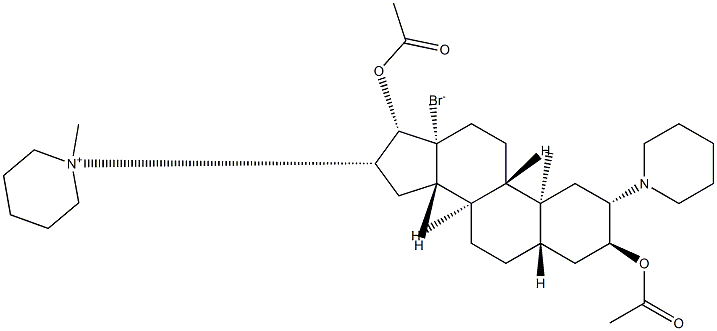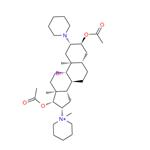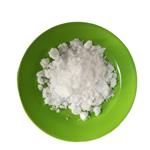Description
Vecuronium bromide (Brand name: Norcuron) is a drug which can be supplied to general anesthesia to keep skeletal muscle relaxation during the surgery or mechanical ventilation. It can also be used to help with endotracheal intubation. It has rapid onset (within 4 minutes) and has its effect last for 4 hour. Its mechanism of action is through competitively binding to the nicotinic cholinergic receptors, further antagonizing the opportunity for acetylcholine from binding to the nicotinic receptor at the postjunctional membrane of the myoneural junction. This process prevents the depolarization and the release of calcium ions, stopping muscle contraction and help muscle relaxation.
References
https://en.wikipedia.org/wiki/Vecuronium_bromide
https://www.drugbank.ca/drugs/DB01339
Description
Vecuronium is a non-depolarizing muscle relaxant derived from the aminosteroid pancuronium and used adjunctively to general anesthesia. It competitively blocks cholinergic receptors at the motor end plate of the neuromuscular junction, inducing temporary paralysis. In humans, it has been shown to reduce muscle twitch tension with an ED
50 value of 0.15 mg/kg for a duration of 27 minutes without inducing cardiovascular effects.
Description
Vecuronium, 1-[(2β,3α,5α,16β,17β,)-3,17-bis(acetyloxy)-2-(1-piperidinyl)
androstan-16-yl]-1-methylpiperidinium bromide (15.1.9), differs from panuronium only in
the extent of alkylation. Only the piperidine substituent on C16 of the steroid skeleton is
transformed into a quaternary salt.
Chemical Properties
White Solid
Uses
An aminosteroid, competitive neuromuscular blocker agent.
Definition
ChEBI: The organic bromide salt of a 5alpha-androstane compound having 3alpha-acetoxy-, 17beta-acetoxy-, 2beta-piperidinino- and 16beta-N-methylpiperidinium su
stituents.
brand name
Norcuron (Organon).
Biological Functions
Vecuronium bromide (Norcuron) is chemically
identical to pancuronium except for a tertiary amine in
place of a quaternary nitrogen. However, some of the
drug will exist as the bisquaternary compound, depending
on body pH. Vecuronium has a moderate onset of
action (2.4 minutes) and a duration of effect of about 50
minutes. Like pancuronium, it does not block ganglia or
vagal neuroeffector junctions, does not release histamine,
and is eliminated by urinary excretion.
General Description
Vecuronium bromide, 1-(3 ,17 -dihydroxy-2 -piperidino-5 -androstan-16 -yl)-1-methylpiperidinium bromide diacetate (Norcuron), is themonoquaternary analog of pancuronium bromide. It belongsto the class of nondepolarizing neuromuscular blockingagents and produces effects similar to those of drugs in thisclass. It is unstable in the presence of acids and undergoesgradual hydrolysis of its ester functions in aqueous solution.Aqueous solutions have a pH of about 4.0.
Mechanism of action
Vecuronium bromide is a bisquaternary nitrogen compound that acts by competitively binding to nicotinic cholinergic receptors. The binding of vecuronium decreases the opportunity for acetylcholine to bind to the nicotinic receptor at the postjunctional membrane of the myoneural junction. As a result, depolarization is prevented, calcium ions are not released and muscle contraction does not occur.
Pharmacology
Vecuronium bromide is steroidal agent that was developed in an attempt to
reduce the cardiovascular effects of pancuronium. I t is similar in structure to
the older drug, differing only in the loss of a methyl group from one
quaternary ammonium radical. Thus it is a monoquaternary amine. An intubating dose of 0.1mgkg
-1 produces profound neuromuscular block
within 3min. This dose produces clinical block for about 30min. Vecuronium
rarely produces histamine release, nor does it have any direct cardiovascular
effects, although it allows the cardiac effects of other anaesthetic agents, such as bradycardia produced by the opioids, to go unchallenged. Vecuronium is
excreted through the kidneys (30%), although to a lesser extent than
pancuronium, and undergoes hepatic deacetylation; the deacetylated
metabolites have neuromuscular blocking properties. Repeated doses should
be used with care in patients with renal or hepatic disease because they
accumulate.
Clinical Use
Vecuronium Bromide is usedmainly to produce skeletal muscle relaxation during surgeryand to assist in controlled respiration after general anesthesiahas been induced.
Side effects
Common side effects of Vecuronium bromide include: muscle weakness, redness or inflammation at the injection site. Serious side effects include: measles, difficulty breathing, swelling of the face, lips, tongue, or throat; weak or shallow breathing, persistent muscle weakness, loss of movement in any part of the body, dizziness, and fever.
Veterinary Drugs and Treatments
Vecuronium is indicated as an adjunct to general anesthesia to produce
muscle relaxation during surgical procedures or mechanical
ventilation and to facilitate endotracheal intubation. It causes very
minimal cardiac effects and generally does not cause the release of
histamine.
Drug interactions
Potentially hazardous interactions with other drugs
Anaesthetics: enhanced muscle relaxant effect.
Anti-arrhythmics: procainamide enhances muscle
relaxant effect.
Antibacterials: effect enhanced by aminoglycosides,
clindamycin, polymyxins and piperacillin.
Antiepileptics: muscle relaxant effects antagonised by
carbamazepine; effects reduced by long-term use of
fosphenytoin and phenytoin but might be increased
by acute use.
Botulinum toxin: neuromuscular block enhanced
(risk of toxicity).
Metabolism
Vecuronium partly metabolised by the liver; the metabolites have some neuromuscular blocking activity. It is excreted mainly in bile as unchanged drug and metabolites; some is also excreted in the urine.




